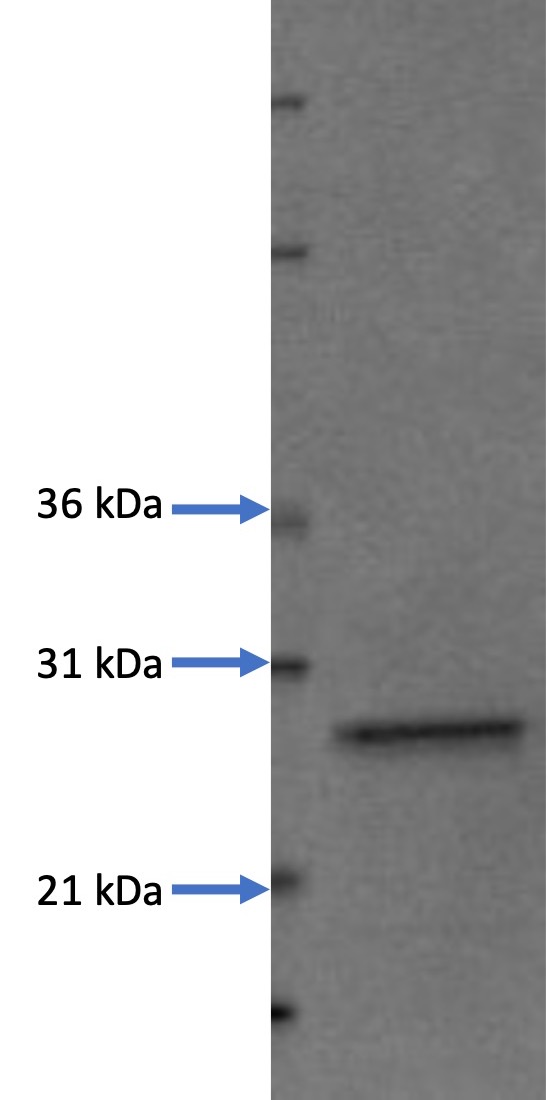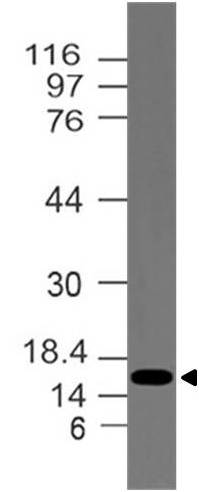Recombinant Mouse PD-L1/B7-H1/CD274 (C-6His)
Shipping Info:
For estimated delivery dates, please contact us at [email protected]
| Amount : | 50 µg |
| Content : | Lyophilized from a 0.2 µm filtered solution of 20mM PB, 150mM NaCl, pH 7.4. |
| Storage condition : | Lyophilized protein should be stored at -20°C, though stable at room temperature for 3 weeks. Reconstituted protein solution can be stored at 4-7°C for 2-7 days. Aliquots of reconstituted samples are stable at -20°C for 3 months. |
| AA sequence : | FTITAPKDLYVVEYGSNVTMECRFPVERELDLLALVVYWEKEDEQVIQFVAGEEDLKPQHSNFRGRASLPKDQLLKGNAALQITDVKLQDAGVYCCIISYGGADYKRITLKVNAPYRKINQRISVDPATSEHELICQAEGYPEAEVIWTNSDHQPVSGKRSVTTSRTEGMLLNVTSSLRVNATANDVFYCTFWRSQPGQNHTAELIIPELPATHPPQNRTVDHHHHHH |
Source: Human Cells.
MW :25.6kD.
Recombinant Mouse Programmed Cell Death 1 Ligand 1 is produced by our Mammalian expression system and the target gene encoding Phe19-Thr238 is expressed with a 6His tag at the C-terminus. Mouse Programmed cell death 1 ligand 1(Cd274,PD-L1), is a member of the growing B7 family of immune proteins.It involved in the costimulatory signal essential for T-cell proliferation and IFNG production in a PDCD1-independent manner. Interaction with PDCD1 inhibits T-cell proliferation by blocking cell cycle progression and cytokine production.B7-H1 has been identified as one of two ligands for programmed death1 (PD1), a member of the CD28 family of immunoreceptors. B7-H1 is constitutively expressed in several organs such as heart, skeletal muscle B7-H1 expression is upregulated in a small fraction of activated T and B cells and a much larger fraction of activated monocytes. The costimulatory function of B7-H1 is critical for enhancing maturation and differentiation of T-cells in lymphoid organs.B7-H1 expression is also induced in dendritic cells and keratinocytes after IFN gamma stimulation. Interaction of B7-H1 with PD1 results in inhibition of TCR-mediated proliferation and cytokine production. The B7-H1:PD1 pathway is involved in the negative regulation of some immune responses and may play an important role in the regulation of peripheral tolerance.
MW :25.6kD.
Recombinant Mouse Programmed Cell Death 1 Ligand 1 is produced by our Mammalian expression system and the target gene encoding Phe19-Thr238 is expressed with a 6His tag at the C-terminus. Mouse Programmed cell death 1 ligand 1(Cd274,PD-L1), is a member of the growing B7 family of immune proteins.It involved in the costimulatory signal essential for T-cell proliferation and IFNG production in a PDCD1-independent manner. Interaction with PDCD1 inhibits T-cell proliferation by blocking cell cycle progression and cytokine production.B7-H1 has been identified as one of two ligands for programmed death1 (PD1), a member of the CD28 family of immunoreceptors. B7-H1 is constitutively expressed in several organs such as heart, skeletal muscle B7-H1 expression is upregulated in a small fraction of activated T and B cells and a much larger fraction of activated monocytes. The costimulatory function of B7-H1 is critical for enhancing maturation and differentiation of T-cells in lymphoid organs.B7-H1 expression is also induced in dendritic cells and keratinocytes after IFN gamma stimulation. Interaction of B7-H1 with PD1 results in inhibition of TCR-mediated proliferation and cytokine production. The B7-H1:PD1 pathway is involved in the negative regulation of some immune responses and may play an important role in the regulation of peripheral tolerance.
Endotoxin : Less than 0.1 ng/µg (1 IEU/µg) as determined by LAL test.
For Research Use Only. Not for use in diagnostic/therapeutics procedures.
| Subcellular location: | Cell membrane, Early endosome membrane, Recycling endosome membrane |
| Post transnational modification: | Ubiquitinated; STUB1 likely mediates polyubiquitination of PD-L1/CD274 triggering its degradation. |
| Tissue Specificity: | Highly expressed in the heart, thymus, skeletal muscle, and lung. Weakly expressed in the kidney, spleen, thyroid, and liver. Expressed on activated dendritic cells, B-cells and macrophages. Expressed in numerous tumor cells lines of lymphoid origin. |
|
There are currently no product reviews
|


















.png)










